|
|
 |
• Содержание выпуска •
• Methods for Optimal Control and Control Theory •
• Artificial Intelligence, Intelligence Systems, Neural Networks •
• Software and Hardware for Distributed Systems and Supercomputers •
• Mathematical Foundations of Programming •
Software and Hardware for Distributed Systems and Supercomputers
Responsible for the Section: Sergei Abramov, Dr. Phys.-Math.Sci.,
corresponding member of RAS
On the left: assigned number of the paper, submission date, the number
of A5 pages contained in the paper,
and the reference to the full-text PDF
/r1/pdf.jpg) . .
|
Article #
7_2021
19
p.
/r1/pdf.jpg) PDF
PDF |
submitted on 15th
Yan 2021 displayed on
website on 12th May
2021 Elena A. Aksenova, Anna A.
Lazutina, Andrew V. Sokolov
About optimal managment of work-stealing deques in two-level
memory
The paper analyzes the problem of optimal control of
a work-stealing deque in two-level memory (for example, registers
–random access memory), where probabilities of parallel operations
with the deque are known. The classic sequential cyclic method for
representing a deque in memory is considered. If a deque overflows
or empty, we transfer elements from its middle part from the fast
memory to the slow memory, since data from the end parts of the
deque may be needed earlier. The problem is to find the optimal
number of elements from both sides of the deque to leave in the fast
memory if the deque is full or empty. As an optimality criterion, we
consider the minimum average cost of memory reallocation, which is
necessary in case of overflow or emptying of fast memory. The
simulation model of this process is constructed. The results of
numerical experiments are presented. (In Russian)
Key words: work-stealing balancers, work-stealing deques,
Monte-Carlo method, random walks. |
|
article citation |
http://psta.psiras.ru/read/psta2021_2_53-71.pdf |
|
DOI |
https://doi.org/10.25209/2079-3316-2021-12-2-53-71 |
|
Article #
8_2021
31
p.
/r1/pdf.jpg) PDF
PDF |
submitted on 26th
Yan 2021 displayed on
website on 05th June
2021 Igor E. Zacharov, Oleg A.
Panarin, Sergey G. Rykovanov, Rishat R. Zagidullin, Anton K.
Maliutin, , Shkandybin Yuri Nikolayevich, Assel Y. Yermekova
Monitoring applications on the ZHORES cluster at Skoltech
Standard monitoring tools for cluster computing
systems allow assessing the performance of the whole system, but do
not allow to analyze the performance of applications individually. A
monitoring system for measuring the resources requested by each
application separately was written in Skoltech for the
high-performance Zhores cluster. The monitoring system collects
both, the usual metrics of CPU and GPU utilization, as well as the
CPU and GPU event counters which allow a more detailed analysis of
the resources requested by the application. Service programs
deployed on each node in the cluster send measurements to a common
time series database in one second increments. These data are
analyzed offline to isolate the characteristics associated with the
use of computing resources by each application. This should reveal
suboptimal applications, allow fine-tuning of the cluster functions
and improve the HPC system overall. (In Russian)
Key words: cluster, high performance computing, application
monitoring, CPU / GPU event counters, time series database.
|
|
article citation |
http://psta.psiras.ru/read/psta2021_2_73-103.pdf |
|
DOI |
https://doi.org/10.25209/2079-3316-2021-12-2-73-103 |
|
Article #
12_2021
14
p.
/r1/pdf.jpg) PDF
PDF |
submitted on 28th
Yan 2021 displayed on
website on 26th June
2021 Sergei S. Shumilin
Methods for anchoring boundary nodes when smoothing a triangular
surface mesh
In numerical modeling tasks that use surface meshes,
remeshing is often required. However, while remeshing, distortion
can occur. The accumulation of distortions can lead to the collapse
of the solution. Smoothing algorithms are used to maintain the
quality of the mesh during the calculation. When performing
smoothing using methods that shift the mesh nodes, the border nodes
are usually fixed to avoid distortion. However, simply fixing the
nodes can lead to more severe distortion. This paper presents
methods for working with boundary nodes to control such nodes during
the smoothing process. Algorithms for working with pseudo-3D surface
meshes, which are of particular interest, are also considered. (In Russian)
Key words: computational geometry, smoothing, triangular
mesh, numerical modeling. |
|
article citation |
http://psta.psiras.ru/read/psta2021_2_193-206.pdf |
|
DOI |
https://doi.org/10.25209/2079-3316-2021-12-2-193-206 |
|
Article #
13_2021
13
p.
/r1/pdf.jpg) PDF
PDF |
submitted on 28th
Yan 2021 displayed on
website on 26th June
2021 Sergei S. Shumilin
Methods for anchoring boundary nodes when smoothing a triangular
surface mesh
In numerical modeling tasks that use surface meshes,
remeshing is often required. However, while remeshing, distortion
can occur. The accumulation of distortions can lead to the collapse
of the solution. Smoothing algorithms are used to maintain the
quality of the mesh during the calculation. When performing
smoothing using methods that shift the mesh nodes, the border nodes
are usually fixed to avoid distortion. However, simply fixing the
nodes can lead to more severe distortion. This paper presents
methods for working with boundary nodes to control such nodes during
the smoothing process. Algorithms for working with pseudo-3D surface
meshes, which are of particular interest, are also considered.
Key words: computational geometry, smoothing, triangular
mesh, numerical modeling. |
|
article citation |
http://psta.psiras.ru/read/psta2021_2_207-219.pdf |
|
DOI |
https://doi.org/10.25209/2079-3316-2021-12-2-207-219 |
|
|
|
|
|
|
|
|
|
• Содержание выпуска •
• Methods for Optimal Control and Control Theory •
• Artificial Intelligence, Intelligence Systems, Neural Networks •
• Software and Hardware for Distributed Systems and Supercomputers •
• Mathematical Foundations of Programming •
|


